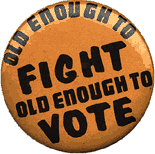“The right of citizens of the United States, who are eighteen years of age or older, to vote shall not be denied or abridged by the United States or by any State on account of age.”
– The Twenty-Sixth Amendment to the U.S. Constitution
On this day in 1971, North Carolina became the 38th state to approve the 26th Amendment, giving the amendment the required approval by at least three-quarters of the states.
The amendment came about due to the growing belief that it was unfair to force young men to fight in the Vietnam War when they couldn’t even vote for or against the elected leaders who put them there.
In 1970, Congress passed an extension of the 1965 Voting Rights Act with a provision that lowered the voting age from 21 to 18 in federal and state elections. This provision was soon struck down by the U.S. Supreme Court, which concluded in Oregon v. Mitchell that Congress didn’t have the authority to set the voting age for state elections.
Congress responded by proposing the 26th Amendment, which essentially did what the statute was intended to do. The ratification process took less than four months — the shortest time ever for a Constitutional amendment.
A few more interesting factoids, courtesy of the American Bar Association:
- In 1969, Congress introduced 50 resolutions to lower the voting age, but none made it into law.
- In 1970, 18-year-olds had the right to vote in 35 nations.
- Much of the credit for passage of the 26th Amendment has been given to peaceful protests and letter-writing campaigns by young men and women on college campuses and elsewhere.
- The slogan “old enough to fight, old enough to vote” is usually associated with the Vietnam War, but it actually originated during World War II, when two states — Georgia and Kentucky — became the first to lower their voting ages to 18.







